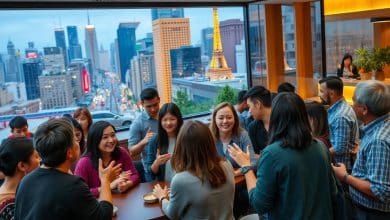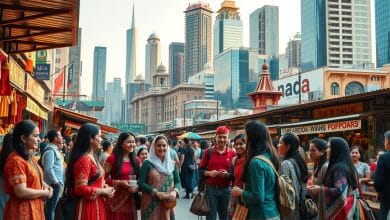How to Choose the Right Cultural Exchange Experience Abroad
Since the 1960s, international programs have connected people across borders through shared learning. These structured initiatives help participants build skills while fostering global collaboration. Today, they remain a powerful way to bridge differences and create meaningful relationships.
Unlike standard travel or short-term volunteering, these experiences demand active engagement. Participants live within host communities, sharing traditions and perspectives. This two-way dialogue helps break down barriers and nurtures mutual understanding that lasts beyond the program’s duration.
Prospective applicants should reflect on their goals. Whether seeking academic growth, career advancement, or personal development, aligning motivations with program objectives ensures a fulfilling journey. Language immersion and hands-on activities often play key roles in shaping outcomes.
It’s also vital to distinguish these opportunities from other abroad options. While study abroad focuses on education and work placements prioritize employment, cultural programs emphasize reciprocal learning. Participants contribute as much as they gain.
Success hinges on readiness to adapt. Building intercultural skills requires openness to new customs, foods, and social norms. Those prepared to engage deeply often form bonds that redefine their view of the world.
Understanding Cultural Exchange Fundamentals
At its core, cultural exchange is about mutual learning through shared human experiences. These interactions create pathways for individuals to explore unfamiliar perspectives while contributing their own. By fostering direct connections, participants gain insights that challenge assumptions and broaden worldviews.
Defining Cultural Exchange and Its Importance
Cultural exchange happens when individuals from distinct backgrounds share customs, values, and daily practices. It goes beyond casual conversations—participants engage in meaningful two-way communication about traditions, beliefs, and social norms. As Mark Twain observed:
“Travel is fatal to prejudice, bigotry, and narrow-mindedness.”
This principle drives programs that turn simple interactions into tools for breaking down barriers.
Historical Context and Global Impact
Early forms of cross-cultural sharing occurred through trade routes and diplomatic missions. Modern structured programs emerged in the 20th century, recognizing intentional dialogue as essential for peacebuilding. Today, these initiatives help communities address global challenges through collaborative problem-solving.
Effective exchanges require active participation—learning local languages, joining festivals, or discussing societal issues. Unlike brief tourism encounters, they create lasting impacts by fostering genuine respect between diverse groups.
Exploring Types of Cultural Exchange Programs
Diverse formats cater to different goals, from classroom learning to community projects. Each type offers unique ways to connect while addressing specific needs. Let’s examine four common structures shaping global interactions today.
Student Cultural Exchange Programs
These remain the top choice for learners aged 15–25. Participants attend schools abroad while living with local families. This setup blends academics with daily life experiences, fostering language skills and cross-cultural friendships.
Volunteer Cultural Exchange Programs
Ideal for hands-on contributors, these initiatives pair service with learning. Opportunities range from teaching English to wildlife conservation. Participants gain practical skills while addressing community needs through structured collaboration.
Professional Cultural Exchange Programs
Experts in fields like engineering or healthcare share knowledge across borders. These short-term projects often involve workshops or research partnerships. They strengthen international networks while solving shared challenges.
Virtual Cultural Exchange Programs
Digital platforms connect global participants through video calls and forums. These cost-effective options suit those unable to travel. Activities include collaborative projects and language exchanges, breaking geographical barriers.
| Program Type | Duration | Focus Area | Best For |
|---|---|---|---|
| Student | 6–12 months | Academic growth | High school/college learners |
| Volunteer | 2 weeks–3 months | Community service | Hands-on contributors |
| Professional | 1–6 weeks | Career development | Industry experts |
| Virtual | Flexible | Digital collaboration | Budget-conscious participants |
Key Benefits of Cultural Exchange Participation
Global exchange experiences create ripple effects that extend far beyond borders. Participants gain tools to navigate diverse environments while forming connections that reshape their worldview. These programs offer layered rewards that continue unfolding long after returning home.
Developing Soft Skills and Adaptability
Navigating unfamiliar social norms sharpens problem-solving abilities. Participants learn to organize daily tasks in new contexts, from public transportation to market interactions. This builds self-confidence that transfers to both personal challenges and workplace scenarios.
Building Intercultural Competence and Lifelong Bonds
Sharing meals with host families or discussing local traditions reveals hidden aspects of one’s own background. These moments foster empathy, creating a dual perspective that enriches future interactions. Many form friendships spanning decades, with 78% of alumni reporting ongoing contact according to recent surveys.
Enhancing Career and Personal Growth
Employers increasingly value candidates who demonstrate cross-cultural fluency. Experience abroad signals adaptability—a key asset in global industries. Beyond resumes, participants often discover renewed purpose through meaningful contributions to host communities.
As one recent participant noted: “Learning to work alongside people with completely different life experiences taught me more about leadership than any textbook.” These programs don’t just change itineraries—they transform how people engage with the world.
Essential Considerations for Study Abroad and Exchange Experiences
Selecting the right program hinges on understanding deep cultural integration versus superficial stays. Students must balance academic goals with opportunities to engage authentically in their host communities. This requires careful planning to maximize learning while maintaining personal well-being.
Cultural Immersion and Local Engagement
True immersion means joining local festivals, markets, and family routines. Students who shop at neighborhood stores or help prepare meals with their host family gain insights textbooks can’t provide. One participant shared: “Learning to cook traditional dishes taught me more about my host country’s values than any museum tour.”
Programs prioritizing community involvement often include language partners or collaborative projects. These experiences build bridges between visitors and residents, creating mutual learning moments. Daily interactions—like using public transit or attending religious services—shape lasting intercultural skills.
Evaluating Destination and Program Fit
Researching climate, social norms, and safety standards helps students avoid culture shock. A coastal town’s relaxed pace might suit some learners better than a bustling capital city. Matching personal preferences with a location’s realities ensures smoother adaptation.
Host family compatibility matters. Discussing dietary needs, curfews, and communication styles upfront prevents misunderstandings. Reputable programs provide detailed profiles to help students find households aligned with their comfort levels.
Finally, verify support systems. Quality initiatives offer 24/7 emergency contacts and cultural mentors. This safety net allows students to explore independently while knowing help remains available when needed.
Expert Strategies for Choosing Cultural Exchange Programs
Navigating the world of international programs demands careful evaluation and self-reflection. Participants must balance practical logistics with personal aspirations to find initiatives that deliver transformative experiences.
Assessing Provider Credibility and Standards
Trustworthy organizations maintain accreditation from recognized bodies like UNESCO or the U.S. Bureau of Educational and Cultural Affairs. Always verify:
- Program duration matching academic calendars
- Clear safety protocols for host communities
- Transparent cost breakdowns with scholarship options
Reputable institutions partner with established schools and local networks. One foreign exchange student noted: “My host university’s 24/7 support team made all the difference during unexpected challenges.”
Aligning Objectives with Program Features
Effective international exchange requires matching personal ambitions to program structures. Ask these questions:
- Does the curriculum support language immersion goals?
- Will location-specific activities advance career skills?
- Do partner institutions offer relevant academic resources?
Medical students often thrive in programs with hospital shadowing, while aspiring educators benefit from classroom teaching opportunities. Financial planning remains crucial—compare housing stipends and meal allowances across different organizations.
Practical Tips for Preparation and Adaptation
Smart groundwork turns potential culture shock into exciting discovery. Participants who invest time understanding local customs before departure often adapt faster. This proactive approach builds confidence for forming authentic connections.
Pre-Departure Cultural Research
Watch documentaries showing daily life in your host region. Learn key phrases like “please” and “thank you”—this effort shows respect. A former participant advised: “Mastering three greetings made my host family beam with pride.”
Join online forums where alumni share hidden rules. These groups reveal details like appropriate gift-giving practices or meal-time etiquette. Check embassy websites for current safety guidelines.
Managing Expectations and Embracing Change
Pack clothes suitable for local weather and cultural norms. Create a mental checklist for common adjustments:
- Different meal schedules
- Alternative transportation methods
- Varied communication styles
Host families value visitors who ask about traditions. One father shared: “Our student’s questions about harvest festivals led to amazing storytelling nights.”
Insights from Past Exchange Participants
“I thought I’d hate the food, but trying new dishes became my favorite way to bond with neighbors.”
Many suggest bringing photos from home to share during family meals. Schedule weekly check-ins with loved ones while staying engaged in local activities. Leave room for surprises—unplanned moments often create lasting memories.
Leveraging Technology and Community for a Successful Exchange
Modern global connections thrive at the intersection of digital tools and human relationships. Smart use of resources helps participants bridge distances while deepening their understanding of new environments. This balance transforms short-term stays into enduring partnerships.
Online Platforms and Virtual Learning Tools
Apps like Duolingo and Zoom keep exchange students connected to both home and host countries. Video journals let families follow daily discoveries, turning personal growth into shared stories. One participant noted: “Posting cooking videos with my host mom taught my friends back home more about her culture than any textbook.”
Language exchange forums pair learners with native speakers worldwide. These digital spaces offer 24/7 practice opportunities beyond classroom hours. Many programs now include virtual reality tours to prepare students for local landmarks before arrival.
Building Connections with Host Families and Local Communities
Successful homestays begin with curiosity about household routines. Asking to help prepare meals or learn folk songs builds trust faster than formal interviews. A host father shared: “Our student’s interest in gardening led to amazing conversations about sustainable farming across continents.”
Neighborhood festivals and volunteer projects create natural bonding moments. Joining a community clean-up or sports team shows commitment beyond being a temporary visitor. These efforts often spark friendships that last decades.
After returning home, many maintain ties through social media groups celebrating their host town’s holidays. Regular video calls keep traditions alive while planning future reunions. Technology becomes the bridge sustaining what personal interactions began.
Conclusion
Global understanding grows when people commit to shared learning. Providers and participants work together to create bridges between nations through structured programs. These efforts strengthen communities while offering life-changing experiences.
Students gain fresh perspectives by living in another country. Professionals develop skills through international exchange initiatives. Even virtual programs help participants explore new cultures without leaving home.
Every person who joins these opportunities contributes to a more connected world. Whether teaching abroad, hosting visitors, or collaborating online, each action builds mutual respect. Lasting change happens when diverse groups engage as equals.
With countless programs available today, there’s never been a better time to get involved. Taking part in this global movement enriches both individual lives and collective futures. The world grows smaller—and richer—when we choose to learn from one another.
FAQ
What defines a quality international immersion program?
How do volunteer opportunities differ from academic-focused programs?
Can participating abroad influence future career paths?
What steps help identify the best-fit destination?
How important are pre-departure preparations?
What support do host families typically provide?
Are virtual programs effective for building connections?
How do alumni handle homesickness during stays?
Why does accreditation matter for providers?
What lasting impacts do these experiences create?
Published on: 20 de August de 2025







